CYBG PLC Audit Issues Report: ACCT20075, Term 1, CQUniversity
VerifiedAdded on 2023/03/17
|19
|3694
|82
Report
AI Summary
This report provides a comprehensive analysis of the audit issues pertaining to CYBG PLC CDI 1:1 Foreign Exempt LSE. The report begins by examining the concept of materiality in financial reporting, discussing its significance from the auditor's perspective, and outlining the steps involved in determining materiality levels, including setting benchmarks, determining the level of the benchmark, and justifying the choice. The report then delves into the application of materiality in identifying misstatements and differentiating between group and component materiality. The second section of the report assesses CYBG PLC's financial performance through various ratios, including receivable turnover, asset turnover, return on assets, return on investment, return on equity, gross profit margin, EBITD margin, operating margin, and net profit margin. The analysis reveals concerning trends, such as decreasing profitability and poor performance compared to industry standards. The final section of the report concludes the analysis by highlighting key risk areas for the audit, particularly the company's failure to meet industry standards across multiple financial ratios, and the potential implications of poor management. The report is based on the assignment brief to provide an academic report which addresses the tasks in the context of the allocated ASX listed company.
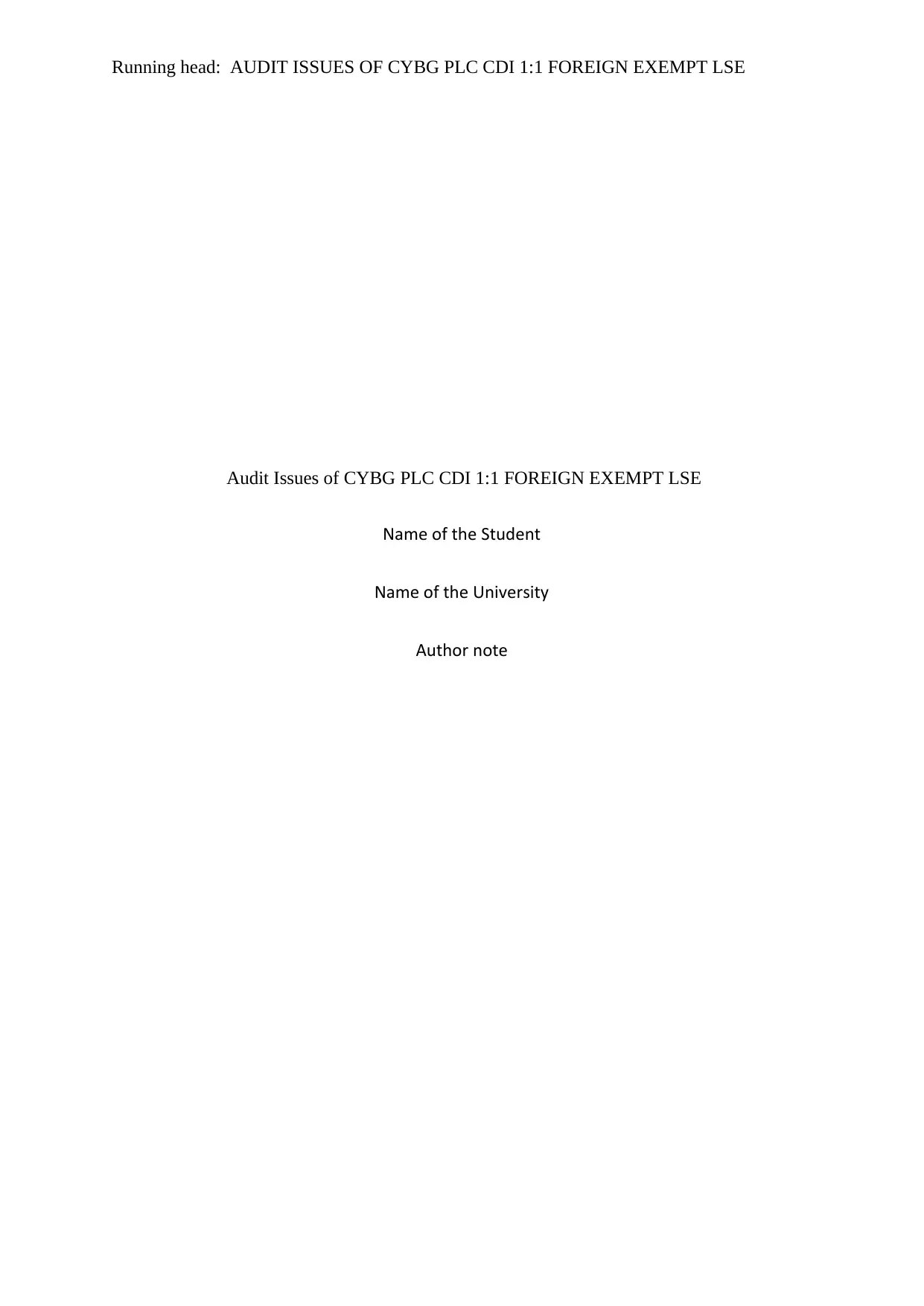
Running head: AUDIT ISSUES OF CYBG PLC CDI 1:1 FOREIGN EXEMPT LSE
Audit Issues of CYBG PLC CDI 1:1 FOREIGN EXEMPT LSE
Name of the Student
Name of the University
Author note
Audit Issues of CYBG PLC CDI 1:1 FOREIGN EXEMPT LSE
Name of the Student
Name of the University
Author note
Paraphrase This Document
Need a fresh take? Get an instant paraphrase of this document with our AI Paraphraser
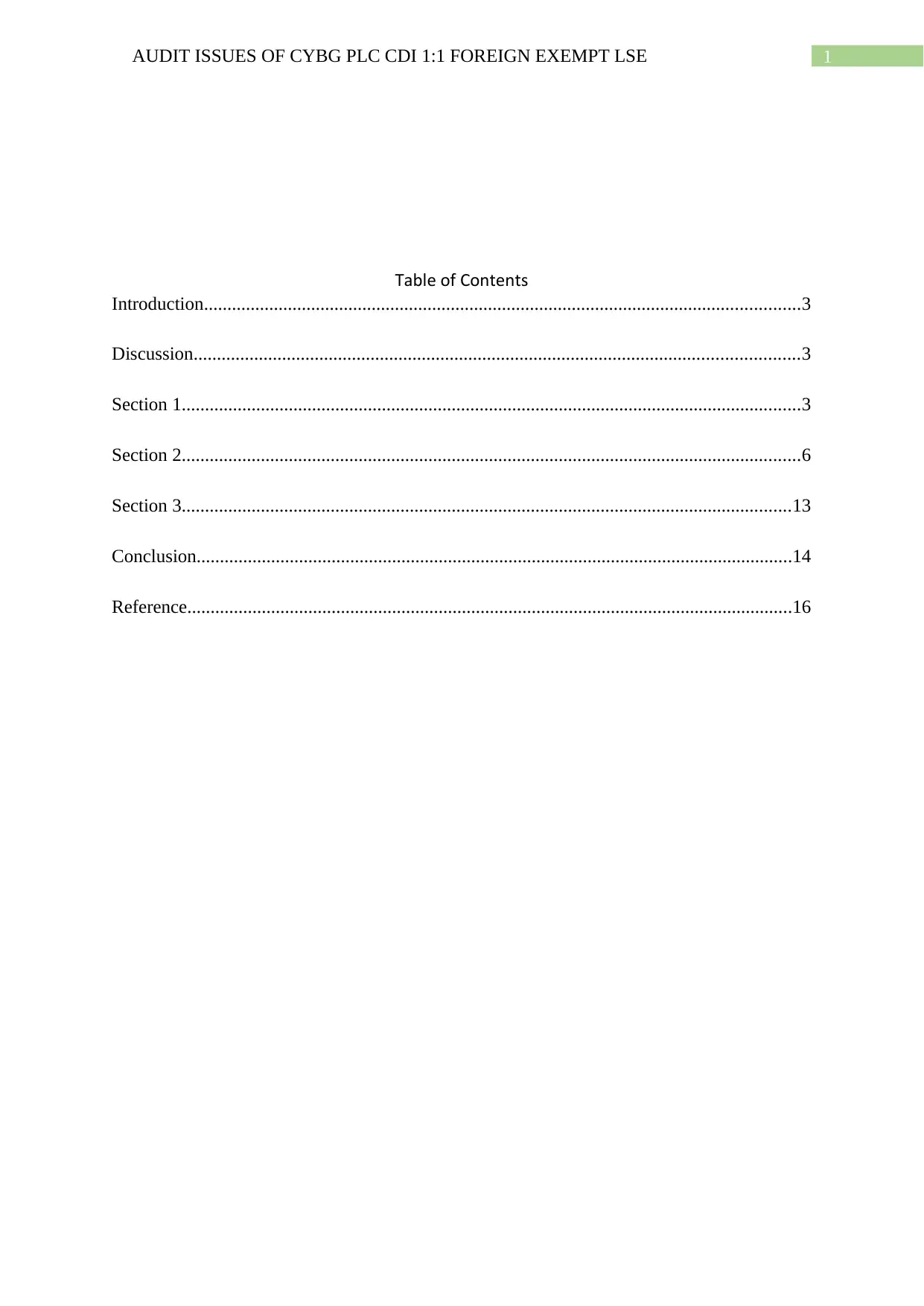
1AUDIT ISSUES OF CYBG PLC CDI 1:1 FOREIGN EXEMPT LSE
Table of Contents
Introduction................................................................................................................................3
Discussion..................................................................................................................................3
Section 1.....................................................................................................................................3
Section 2.....................................................................................................................................6
Section 3...................................................................................................................................13
Conclusion................................................................................................................................14
Reference..................................................................................................................................16
Table of Contents
Introduction................................................................................................................................3
Discussion..................................................................................................................................3
Section 1.....................................................................................................................................3
Section 2.....................................................................................................................................6
Section 3...................................................................................................................................13
Conclusion................................................................................................................................14
Reference..................................................................................................................................16
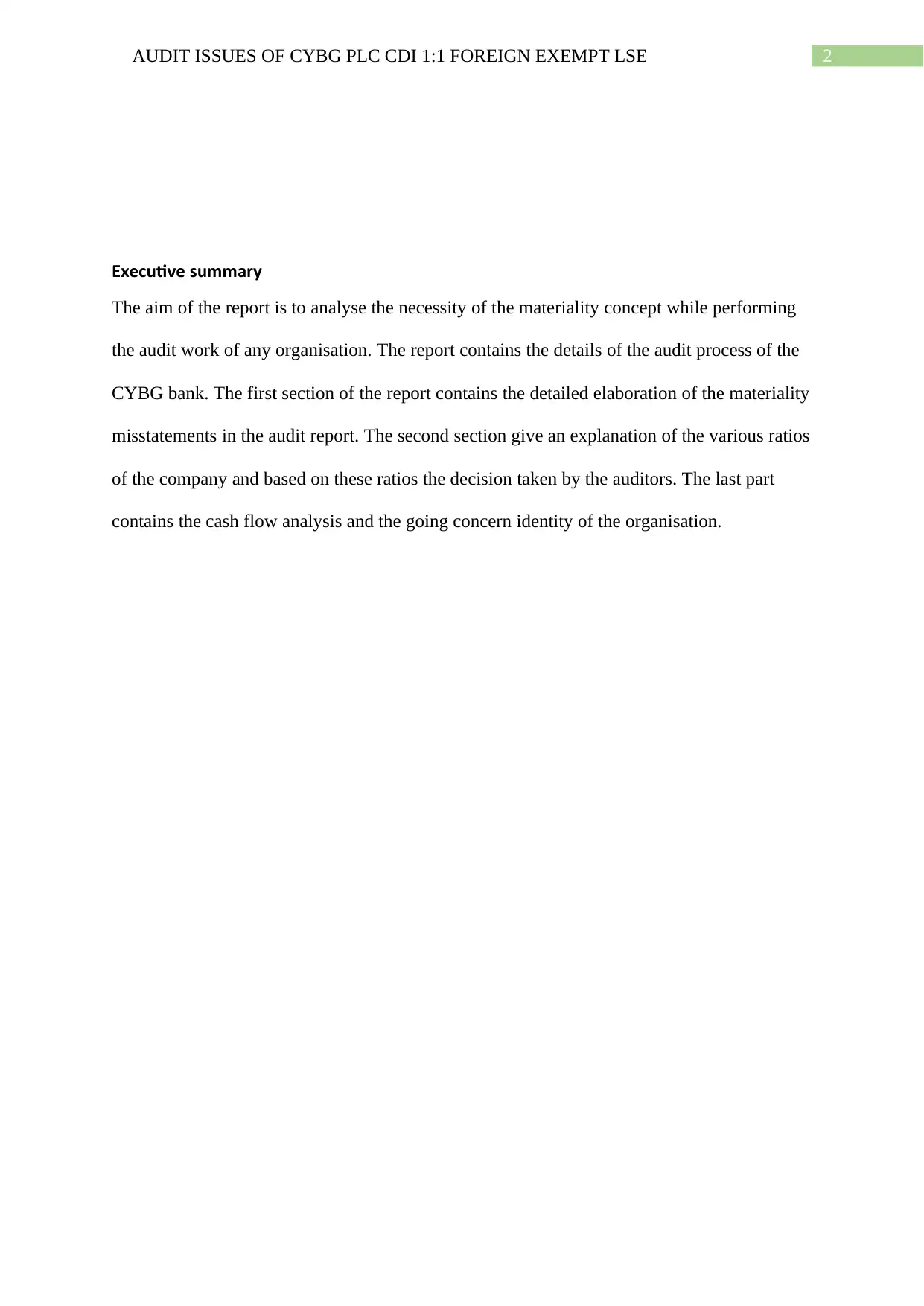
2AUDIT ISSUES OF CYBG PLC CDI 1:1 FOREIGN EXEMPT LSE
Executive summary
The aim of the report is to analyse the necessity of the materiality concept while performing
the audit work of any organisation. The report contains the details of the audit process of the
CYBG bank. The first section of the report contains the detailed elaboration of the materiality
misstatements in the audit report. The second section give an explanation of the various ratios
of the company and based on these ratios the decision taken by the auditors. The last part
contains the cash flow analysis and the going concern identity of the organisation.
Executive summary
The aim of the report is to analyse the necessity of the materiality concept while performing
the audit work of any organisation. The report contains the details of the audit process of the
CYBG bank. The first section of the report contains the detailed elaboration of the materiality
misstatements in the audit report. The second section give an explanation of the various ratios
of the company and based on these ratios the decision taken by the auditors. The last part
contains the cash flow analysis and the going concern identity of the organisation.
⊘ This is a preview!⊘
Do you want full access?
Subscribe today to unlock all pages.

Trusted by 1+ million students worldwide
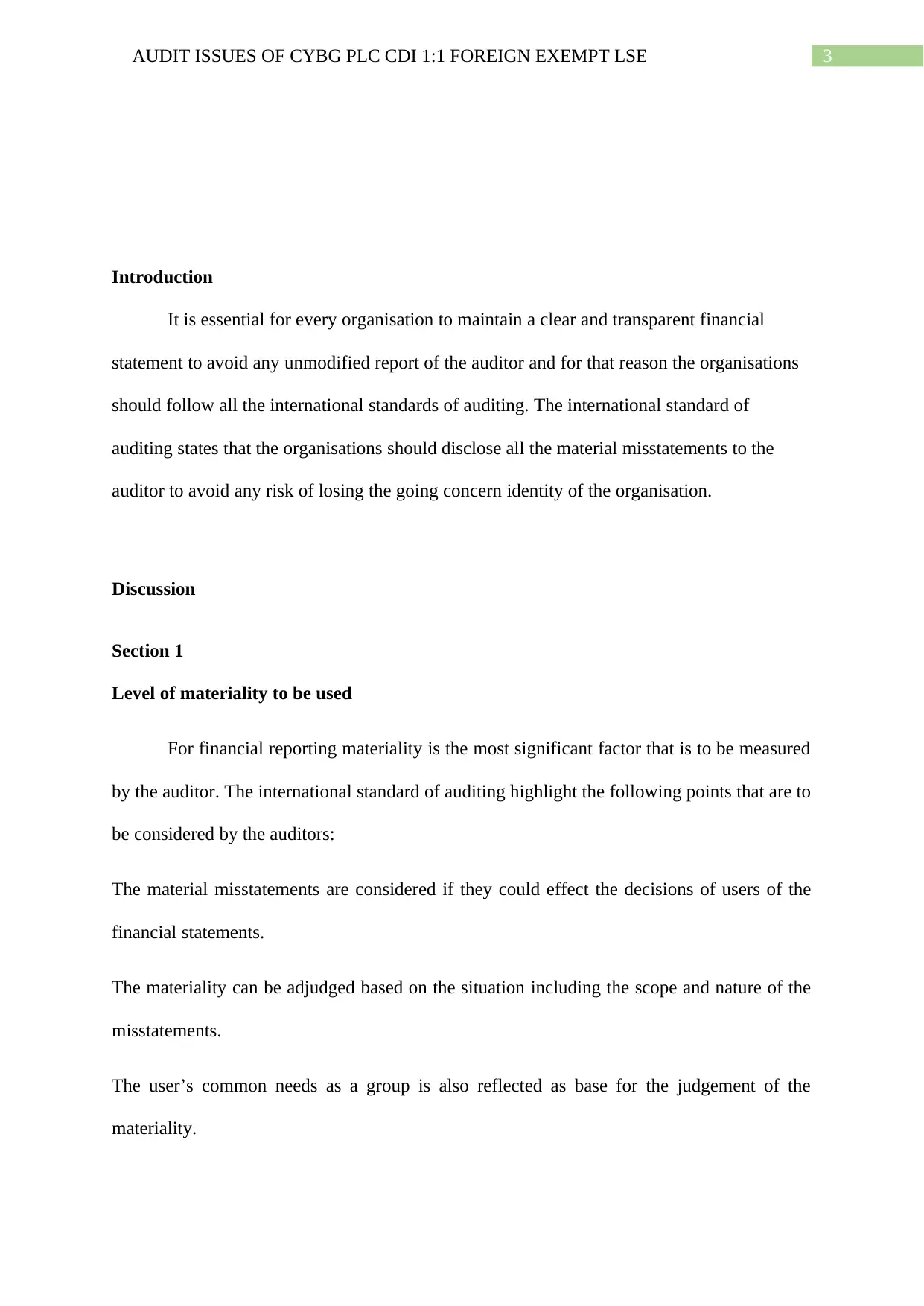
3AUDIT ISSUES OF CYBG PLC CDI 1:1 FOREIGN EXEMPT LSE
Introduction
It is essential for every organisation to maintain a clear and transparent financial
statement to avoid any unmodified report of the auditor and for that reason the organisations
should follow all the international standards of auditing. The international standard of
auditing states that the organisations should disclose all the material misstatements to the
auditor to avoid any risk of losing the going concern identity of the organisation.
Discussion
Section 1
Level of materiality to be used
For financial reporting materiality is the most significant factor that is to be measured
by the auditor. The international standard of auditing highlight the following points that are to
be considered by the auditors:
The material misstatements are considered if they could effect the decisions of users of the
financial statements.
The materiality can be adjudged based on the situation including the scope and nature of the
misstatements.
The user’s common needs as a group is also reflected as base for the judgement of the
materiality.
Introduction
It is essential for every organisation to maintain a clear and transparent financial
statement to avoid any unmodified report of the auditor and for that reason the organisations
should follow all the international standards of auditing. The international standard of
auditing states that the organisations should disclose all the material misstatements to the
auditor to avoid any risk of losing the going concern identity of the organisation.
Discussion
Section 1
Level of materiality to be used
For financial reporting materiality is the most significant factor that is to be measured
by the auditor. The international standard of auditing highlight the following points that are to
be considered by the auditors:
The material misstatements are considered if they could effect the decisions of users of the
financial statements.
The materiality can be adjudged based on the situation including the scope and nature of the
misstatements.
The user’s common needs as a group is also reflected as base for the judgement of the
materiality.
Paraphrase This Document
Need a fresh take? Get an instant paraphrase of this document with our AI Paraphraser
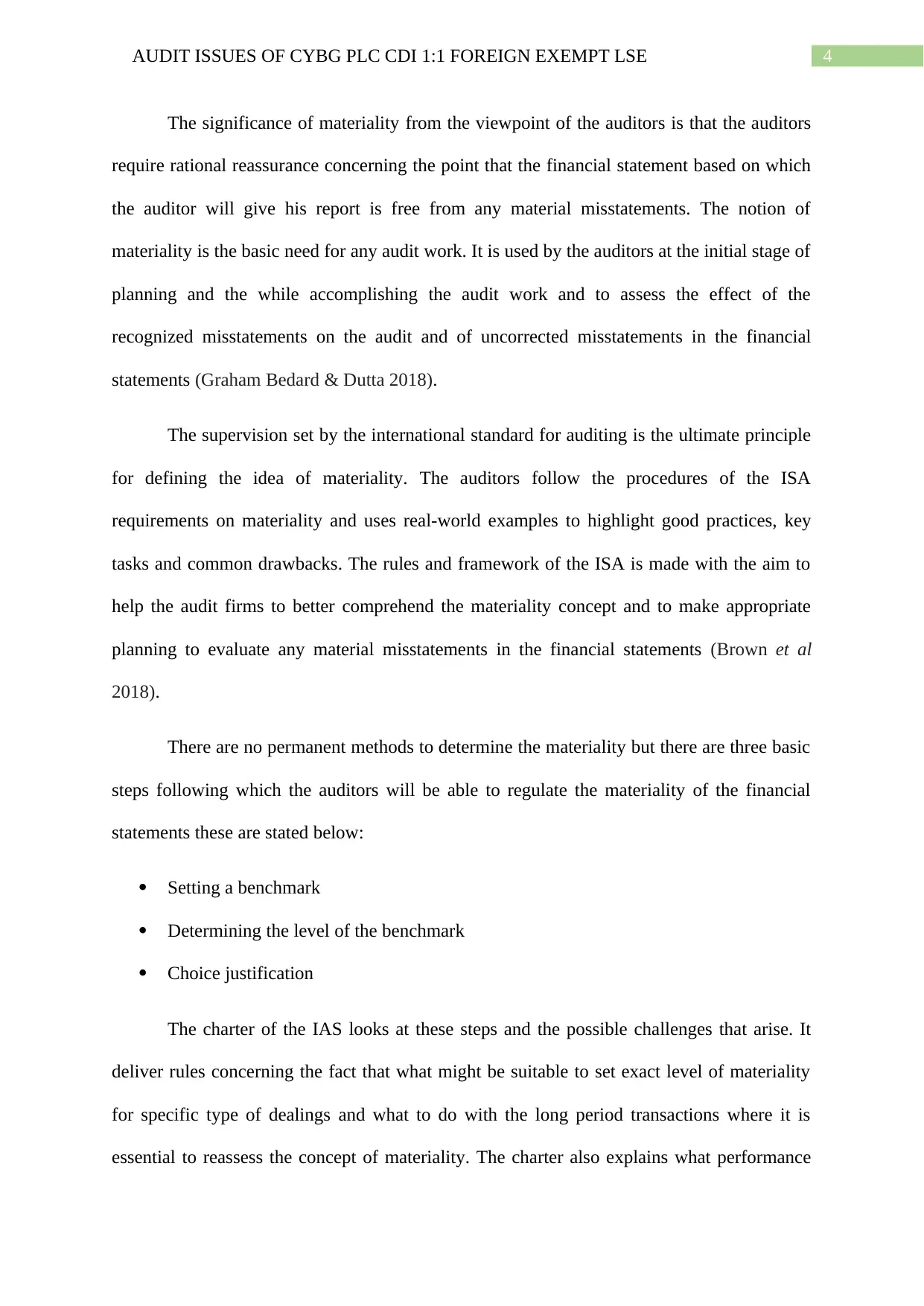
4AUDIT ISSUES OF CYBG PLC CDI 1:1 FOREIGN EXEMPT LSE
The significance of materiality from the viewpoint of the auditors is that the auditors
require rational reassurance concerning the point that the financial statement based on which
the auditor will give his report is free from any material misstatements. The notion of
materiality is the basic need for any audit work. It is used by the auditors at the initial stage of
planning and the while accomplishing the audit work and to assess the effect of the
recognized misstatements on the audit and of uncorrected misstatements in the financial
statements (Graham Bedard & Dutta 2018).
The supervision set by the international standard for auditing is the ultimate principle
for defining the idea of materiality. The auditors follow the procedures of the ISA
requirements on materiality and uses real-world examples to highlight good practices, key
tasks and common drawbacks. The rules and framework of the ISA is made with the aim to
help the audit firms to better comprehend the materiality concept and to make appropriate
planning to evaluate any material misstatements in the financial statements (Brown et al
2018).
There are no permanent methods to determine the materiality but there are three basic
steps following which the auditors will be able to regulate the materiality of the financial
statements these are stated below:
Setting a benchmark
Determining the level of the benchmark
Choice justification
The charter of the IAS looks at these steps and the possible challenges that arise. It
deliver rules concerning the fact that what might be suitable to set exact level of materiality
for specific type of dealings and what to do with the long period transactions where it is
essential to reassess the concept of materiality. The charter also explains what performance
The significance of materiality from the viewpoint of the auditors is that the auditors
require rational reassurance concerning the point that the financial statement based on which
the auditor will give his report is free from any material misstatements. The notion of
materiality is the basic need for any audit work. It is used by the auditors at the initial stage of
planning and the while accomplishing the audit work and to assess the effect of the
recognized misstatements on the audit and of uncorrected misstatements in the financial
statements (Graham Bedard & Dutta 2018).
The supervision set by the international standard for auditing is the ultimate principle
for defining the idea of materiality. The auditors follow the procedures of the ISA
requirements on materiality and uses real-world examples to highlight good practices, key
tasks and common drawbacks. The rules and framework of the ISA is made with the aim to
help the audit firms to better comprehend the materiality concept and to make appropriate
planning to evaluate any material misstatements in the financial statements (Brown et al
2018).
There are no permanent methods to determine the materiality but there are three basic
steps following which the auditors will be able to regulate the materiality of the financial
statements these are stated below:
Setting a benchmark
Determining the level of the benchmark
Choice justification
The charter of the IAS looks at these steps and the possible challenges that arise. It
deliver rules concerning the fact that what might be suitable to set exact level of materiality
for specific type of dealings and what to do with the long period transactions where it is
essential to reassess the concept of materiality. The charter also explains what performance
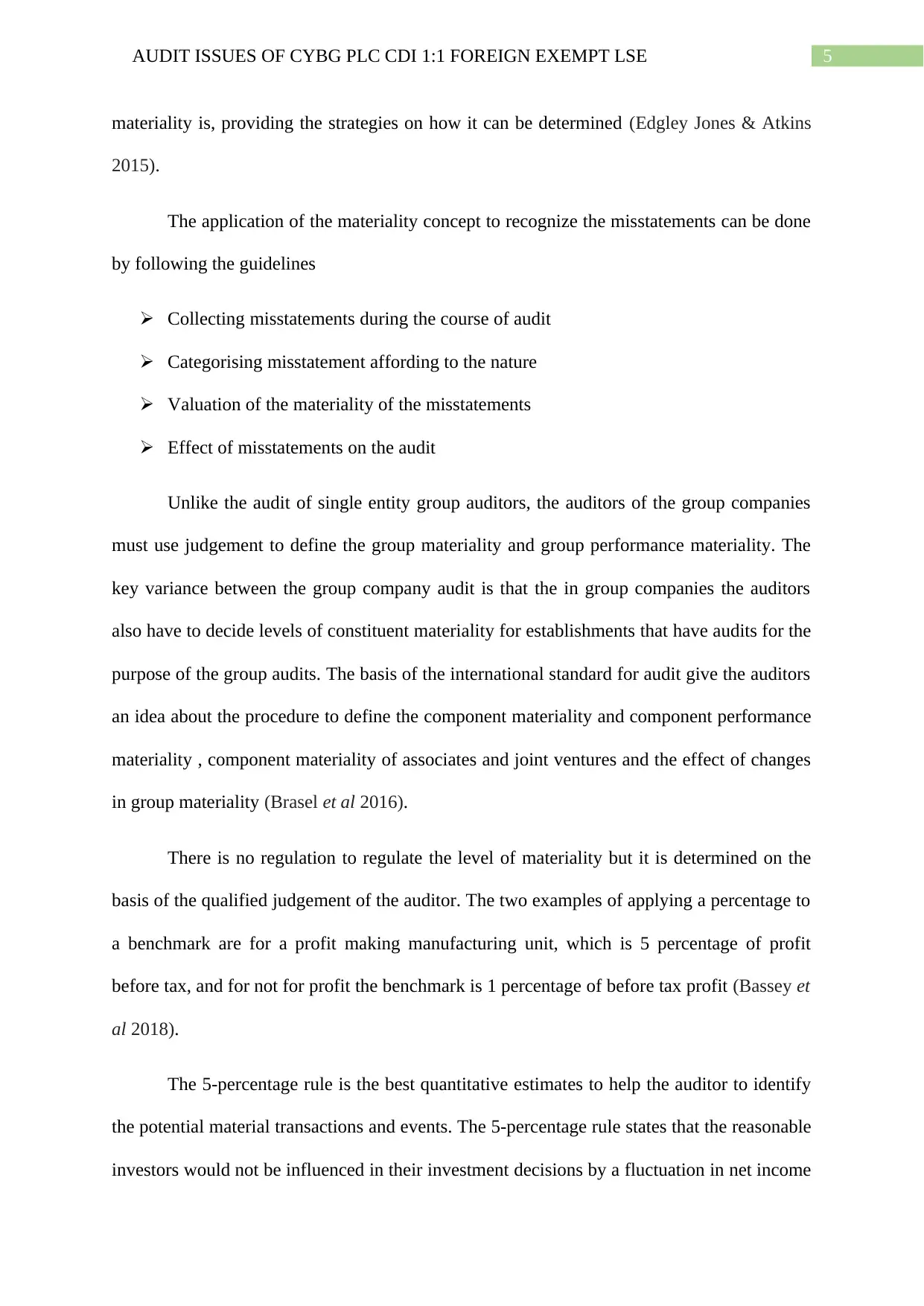
5AUDIT ISSUES OF CYBG PLC CDI 1:1 FOREIGN EXEMPT LSE
materiality is, providing the strategies on how it can be determined (Edgley Jones & Atkins
2015).
The application of the materiality concept to recognize the misstatements can be done
by following the guidelines
Collecting misstatements during the course of audit
Categorising misstatement affording to the nature
Valuation of the materiality of the misstatements
Effect of misstatements on the audit
Unlike the audit of single entity group auditors, the auditors of the group companies
must use judgement to define the group materiality and group performance materiality. The
key variance between the group company audit is that the in group companies the auditors
also have to decide levels of constituent materiality for establishments that have audits for the
purpose of the group audits. The basis of the international standard for audit give the auditors
an idea about the procedure to define the component materiality and component performance
materiality , component materiality of associates and joint ventures and the effect of changes
in group materiality (Brasel et al 2016).
There is no regulation to regulate the level of materiality but it is determined on the
basis of the qualified judgement of the auditor. The two examples of applying a percentage to
a benchmark are for a profit making manufacturing unit, which is 5 percentage of profit
before tax, and for not for profit the benchmark is 1 percentage of before tax profit (Bassey et
al 2018).
The 5-percentage rule is the best quantitative estimates to help the auditor to identify
the potential material transactions and events. The 5-percentage rule states that the reasonable
investors would not be influenced in their investment decisions by a fluctuation in net income
materiality is, providing the strategies on how it can be determined (Edgley Jones & Atkins
2015).
The application of the materiality concept to recognize the misstatements can be done
by following the guidelines
Collecting misstatements during the course of audit
Categorising misstatement affording to the nature
Valuation of the materiality of the misstatements
Effect of misstatements on the audit
Unlike the audit of single entity group auditors, the auditors of the group companies
must use judgement to define the group materiality and group performance materiality. The
key variance between the group company audit is that the in group companies the auditors
also have to decide levels of constituent materiality for establishments that have audits for the
purpose of the group audits. The basis of the international standard for audit give the auditors
an idea about the procedure to define the component materiality and component performance
materiality , component materiality of associates and joint ventures and the effect of changes
in group materiality (Brasel et al 2016).
There is no regulation to regulate the level of materiality but it is determined on the
basis of the qualified judgement of the auditor. The two examples of applying a percentage to
a benchmark are for a profit making manufacturing unit, which is 5 percentage of profit
before tax, and for not for profit the benchmark is 1 percentage of before tax profit (Bassey et
al 2018).
The 5-percentage rule is the best quantitative estimates to help the auditor to identify
the potential material transactions and events. The 5-percentage rule states that the reasonable
investors would not be influenced in their investment decisions by a fluctuation in net income
⊘ This is a preview!⊘
Do you want full access?
Subscribe today to unlock all pages.

Trusted by 1+ million students worldwide
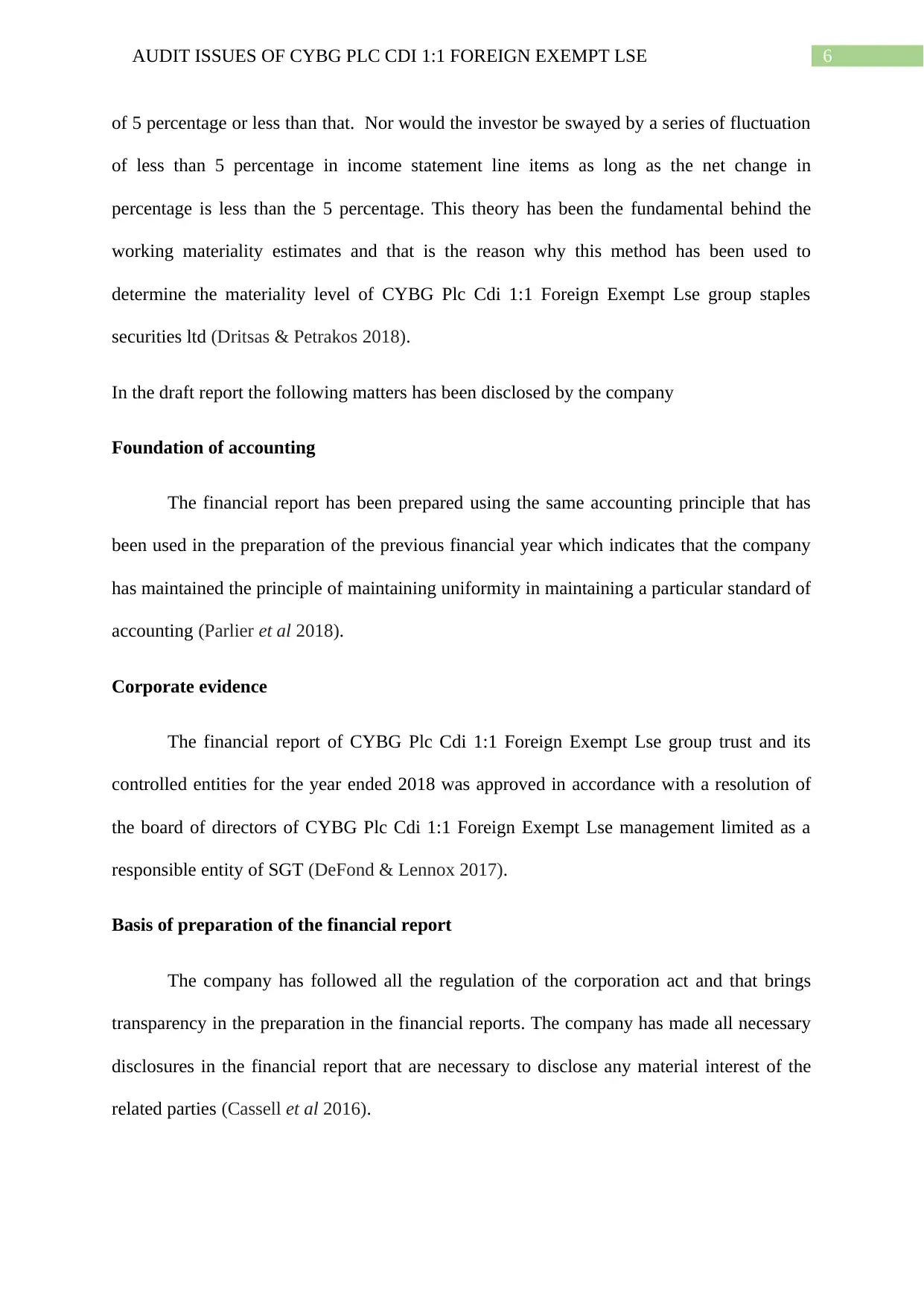
6AUDIT ISSUES OF CYBG PLC CDI 1:1 FOREIGN EXEMPT LSE
of 5 percentage or less than that. Nor would the investor be swayed by a series of fluctuation
of less than 5 percentage in income statement line items as long as the net change in
percentage is less than the 5 percentage. This theory has been the fundamental behind the
working materiality estimates and that is the reason why this method has been used to
determine the materiality level of CYBG Plc Cdi 1:1 Foreign Exempt Lse group staples
securities ltd (Dritsas & Petrakos 2018).
In the draft report the following matters has been disclosed by the company
Foundation of accounting
The financial report has been prepared using the same accounting principle that has
been used in the preparation of the previous financial year which indicates that the company
has maintained the principle of maintaining uniformity in maintaining a particular standard of
accounting (Parlier et al 2018).
Corporate evidence
The financial report of CYBG Plc Cdi 1:1 Foreign Exempt Lse group trust and its
controlled entities for the year ended 2018 was approved in accordance with a resolution of
the board of directors of CYBG Plc Cdi 1:1 Foreign Exempt Lse management limited as a
responsible entity of SGT (DeFond & Lennox 2017).
Basis of preparation of the financial report
The company has followed all the regulation of the corporation act and that brings
transparency in the preparation in the financial reports. The company has made all necessary
disclosures in the financial report that are necessary to disclose any material interest of the
related parties (Cassell et al 2016).
of 5 percentage or less than that. Nor would the investor be swayed by a series of fluctuation
of less than 5 percentage in income statement line items as long as the net change in
percentage is less than the 5 percentage. This theory has been the fundamental behind the
working materiality estimates and that is the reason why this method has been used to
determine the materiality level of CYBG Plc Cdi 1:1 Foreign Exempt Lse group staples
securities ltd (Dritsas & Petrakos 2018).
In the draft report the following matters has been disclosed by the company
Foundation of accounting
The financial report has been prepared using the same accounting principle that has
been used in the preparation of the previous financial year which indicates that the company
has maintained the principle of maintaining uniformity in maintaining a particular standard of
accounting (Parlier et al 2018).
Corporate evidence
The financial report of CYBG Plc Cdi 1:1 Foreign Exempt Lse group trust and its
controlled entities for the year ended 2018 was approved in accordance with a resolution of
the board of directors of CYBG Plc Cdi 1:1 Foreign Exempt Lse management limited as a
responsible entity of SGT (DeFond & Lennox 2017).
Basis of preparation of the financial report
The company has followed all the regulation of the corporation act and that brings
transparency in the preparation in the financial reports. The company has made all necessary
disclosures in the financial report that are necessary to disclose any material interest of the
related parties (Cassell et al 2016).
Paraphrase This Document
Need a fresh take? Get an instant paraphrase of this document with our AI Paraphraser
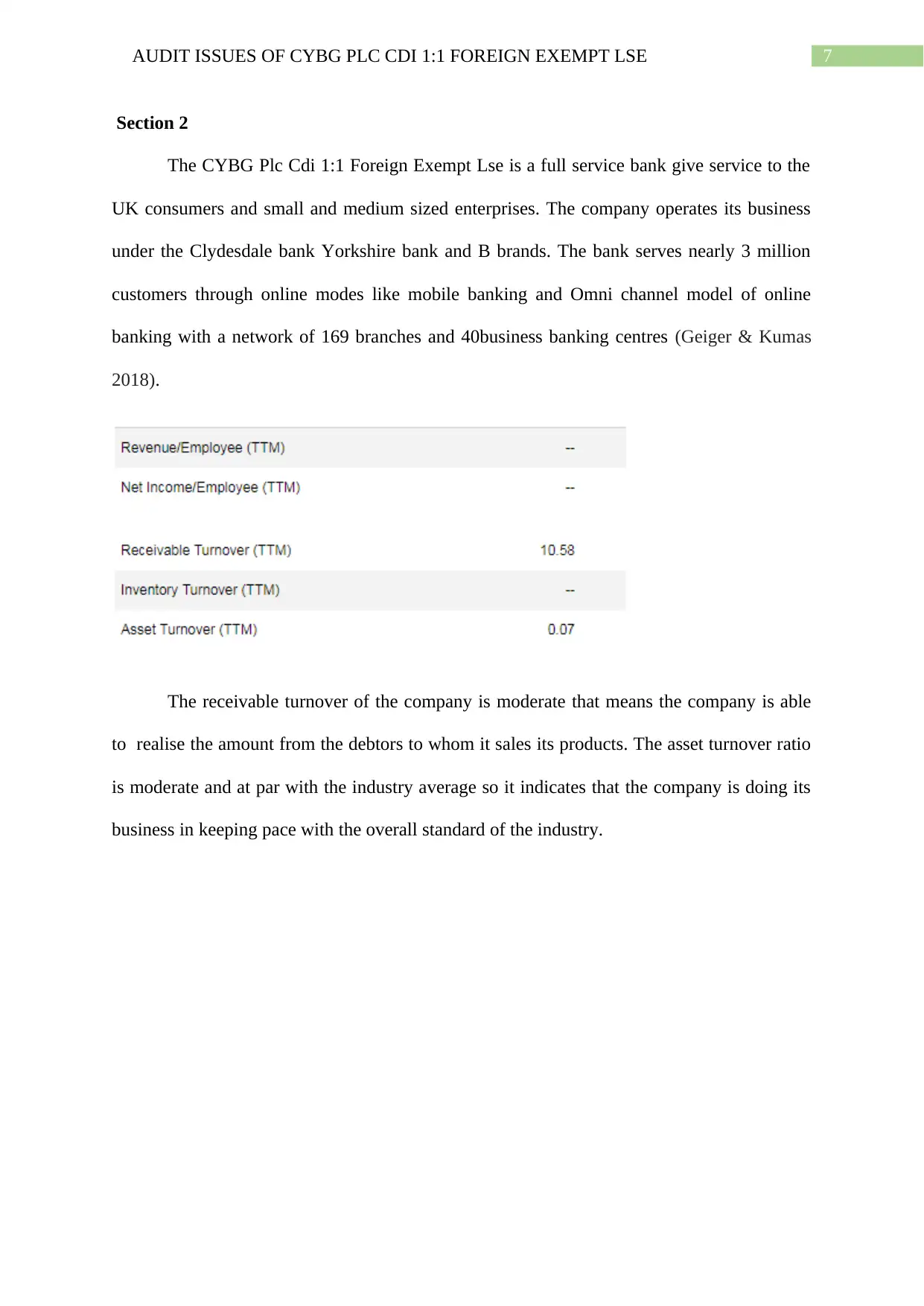
7AUDIT ISSUES OF CYBG PLC CDI 1:1 FOREIGN EXEMPT LSE
Section 2
The CYBG Plc Cdi 1:1 Foreign Exempt Lse is a full service bank give service to the
UK consumers and small and medium sized enterprises. The company operates its business
under the Clydesdale bank Yorkshire bank and B brands. The bank serves nearly 3 million
customers through online modes like mobile banking and Omni channel model of online
banking with a network of 169 branches and 40business banking centres (Geiger & Kumas
2018).
The receivable turnover of the company is moderate that means the company is able
to realise the amount from the debtors to whom it sales its products. The asset turnover ratio
is moderate and at par with the industry average so it indicates that the company is doing its
business in keeping pace with the overall standard of the industry.
Section 2
The CYBG Plc Cdi 1:1 Foreign Exempt Lse is a full service bank give service to the
UK consumers and small and medium sized enterprises. The company operates its business
under the Clydesdale bank Yorkshire bank and B brands. The bank serves nearly 3 million
customers through online modes like mobile banking and Omni channel model of online
banking with a network of 169 branches and 40business banking centres (Geiger & Kumas
2018).
The receivable turnover of the company is moderate that means the company is able
to realise the amount from the debtors to whom it sales its products. The asset turnover ratio
is moderate and at par with the industry average so it indicates that the company is doing its
business in keeping pace with the overall standard of the industry.
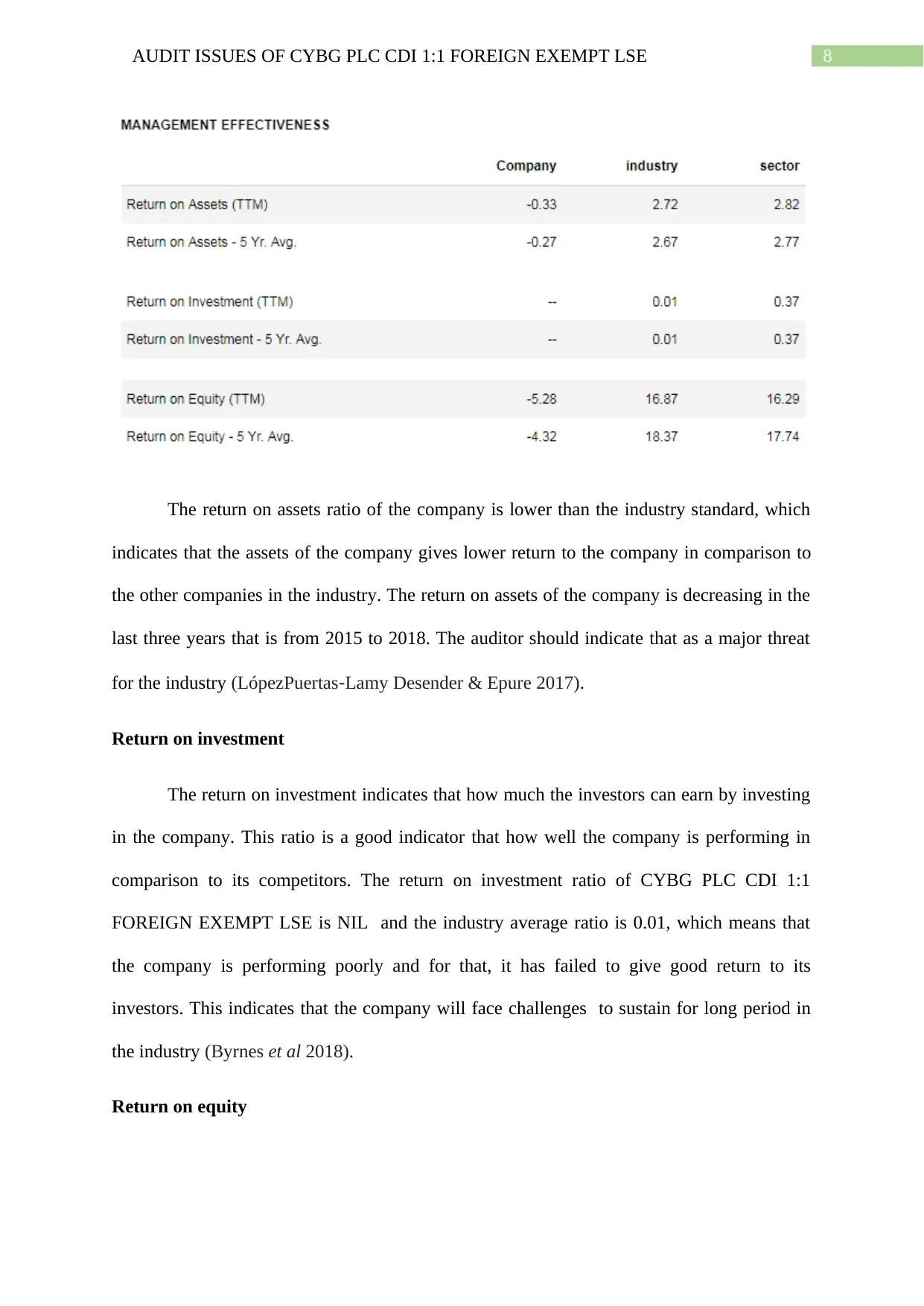
8AUDIT ISSUES OF CYBG PLC CDI 1:1 FOREIGN EXEMPT LSE
The return on assets ratio of the company is lower than the industry standard, which
indicates that the assets of the company gives lower return to the company in comparison to
the other companies in the industry. The return on assets of the company is decreasing in the
last three years that is from 2015 to 2018. The auditor should indicate that as a major threat
for the industry (LópezPuertas‐Lamy Desender & Epure 2017).
Return on investment
The return on investment indicates that how much the investors can earn by investing
in the company. This ratio is a good indicator that how well the company is performing in
comparison to its competitors. The return on investment ratio of CYBG PLC CDI 1:1
FOREIGN EXEMPT LSE is NIL and the industry average ratio is 0.01, which means that
the company is performing poorly and for that, it has failed to give good return to its
investors. This indicates that the company will face challenges to sustain for long period in
the industry (Byrnes et al 2018).
Return on equity
The return on assets ratio of the company is lower than the industry standard, which
indicates that the assets of the company gives lower return to the company in comparison to
the other companies in the industry. The return on assets of the company is decreasing in the
last three years that is from 2015 to 2018. The auditor should indicate that as a major threat
for the industry (LópezPuertas‐Lamy Desender & Epure 2017).
Return on investment
The return on investment indicates that how much the investors can earn by investing
in the company. This ratio is a good indicator that how well the company is performing in
comparison to its competitors. The return on investment ratio of CYBG PLC CDI 1:1
FOREIGN EXEMPT LSE is NIL and the industry average ratio is 0.01, which means that
the company is performing poorly and for that, it has failed to give good return to its
investors. This indicates that the company will face challenges to sustain for long period in
the industry (Byrnes et al 2018).
Return on equity
⊘ This is a preview!⊘
Do you want full access?
Subscribe today to unlock all pages.

Trusted by 1+ million students worldwide
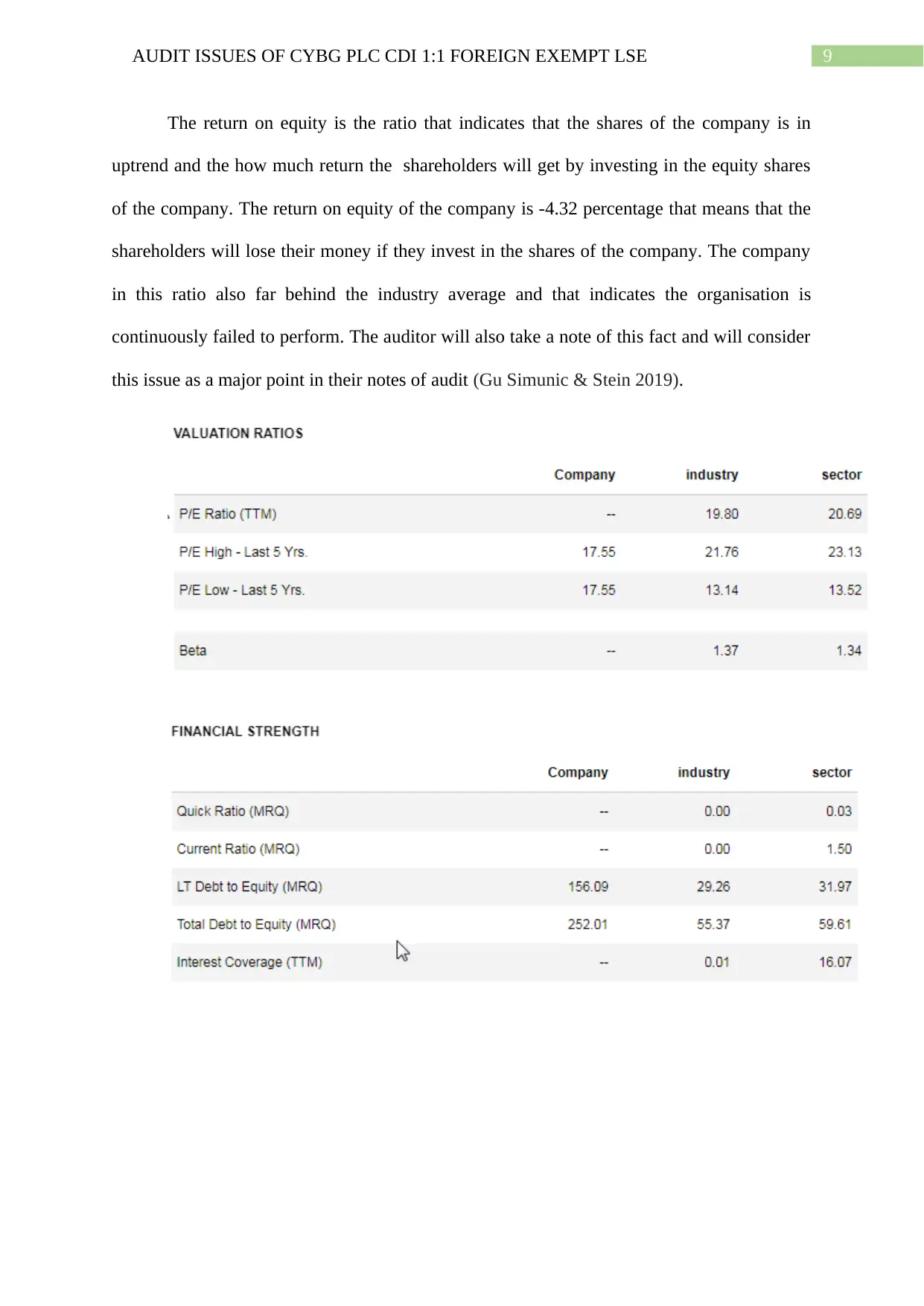
9AUDIT ISSUES OF CYBG PLC CDI 1:1 FOREIGN EXEMPT LSE
The return on equity is the ratio that indicates that the shares of the company is in
uptrend and the how much return the shareholders will get by investing in the equity shares
of the company. The return on equity of the company is -4.32 percentage that means that the
shareholders will lose their money if they invest in the shares of the company. The company
in this ratio also far behind the industry average and that indicates the organisation is
continuously failed to perform. The auditor will also take a note of this fact and will consider
this issue as a major point in their notes of audit (Gu Simunic & Stein 2019).
The return on equity is the ratio that indicates that the shares of the company is in
uptrend and the how much return the shareholders will get by investing in the equity shares
of the company. The return on equity of the company is -4.32 percentage that means that the
shareholders will lose their money if they invest in the shares of the company. The company
in this ratio also far behind the industry average and that indicates the organisation is
continuously failed to perform. The auditor will also take a note of this fact and will consider
this issue as a major point in their notes of audit (Gu Simunic & Stein 2019).
Paraphrase This Document
Need a fresh take? Get an instant paraphrase of this document with our AI Paraphraser
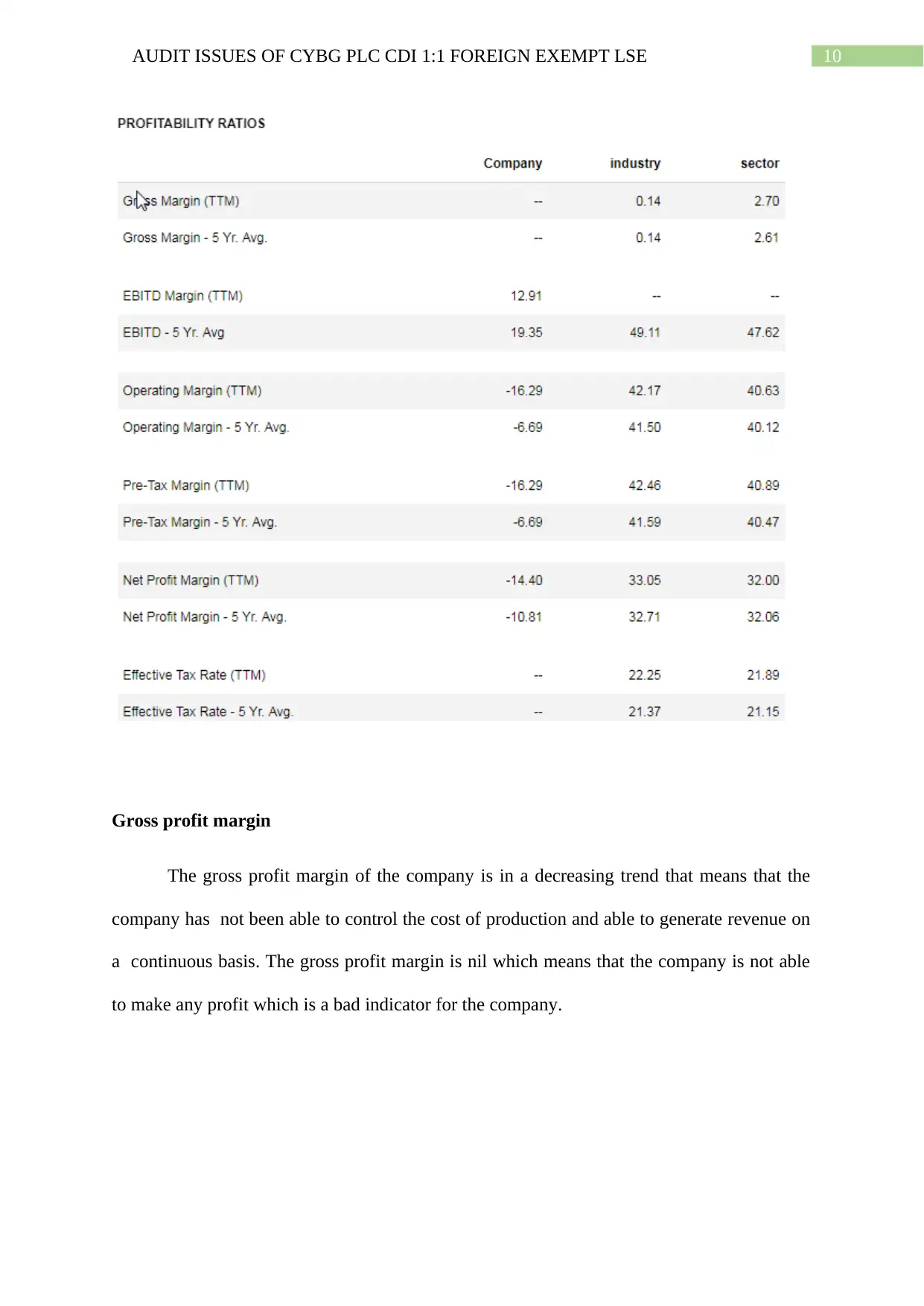
10AUDIT ISSUES OF CYBG PLC CDI 1:1 FOREIGN EXEMPT LSE
Gross profit margin
The gross profit margin of the company is in a decreasing trend that means that the
company has not been able to control the cost of production and able to generate revenue on
a continuous basis. The gross profit margin is nil which means that the company is not able
to make any profit which is a bad indicator for the company.
Gross profit margin
The gross profit margin of the company is in a decreasing trend that means that the
company has not been able to control the cost of production and able to generate revenue on
a continuous basis. The gross profit margin is nil which means that the company is not able
to make any profit which is a bad indicator for the company.
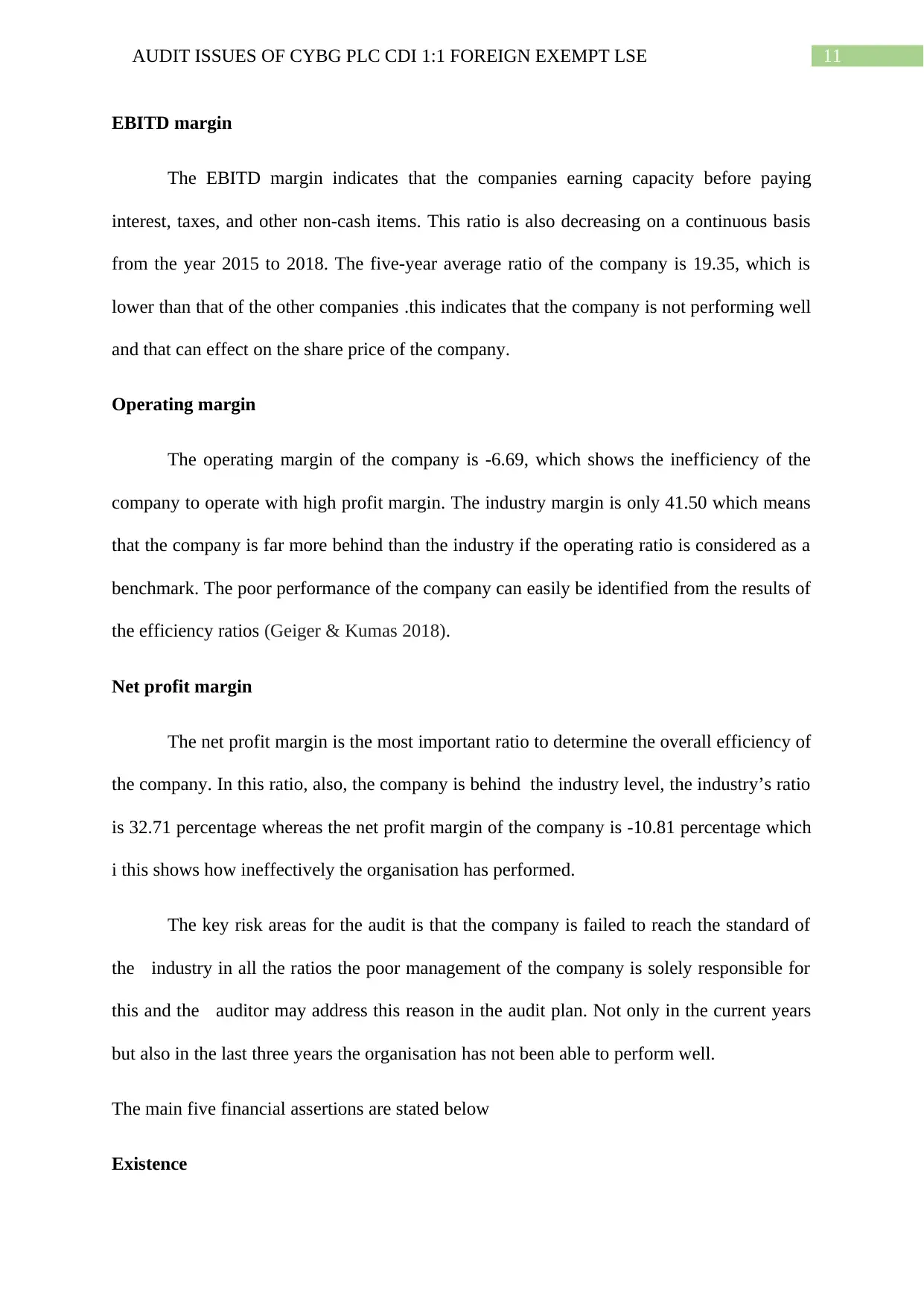
11AUDIT ISSUES OF CYBG PLC CDI 1:1 FOREIGN EXEMPT LSE
EBITD margin
The EBITD margin indicates that the companies earning capacity before paying
interest, taxes, and other non-cash items. This ratio is also decreasing on a continuous basis
from the year 2015 to 2018. The five-year average ratio of the company is 19.35, which is
lower than that of the other companies .this indicates that the company is not performing well
and that can effect on the share price of the company.
Operating margin
The operating margin of the company is -6.69, which shows the inefficiency of the
company to operate with high profit margin. The industry margin is only 41.50 which means
that the company is far more behind than the industry if the operating ratio is considered as a
benchmark. The poor performance of the company can easily be identified from the results of
the efficiency ratios (Geiger & Kumas 2018).
Net profit margin
The net profit margin is the most important ratio to determine the overall efficiency of
the company. In this ratio, also, the company is behind the industry level, the industry’s ratio
is 32.71 percentage whereas the net profit margin of the company is -10.81 percentage which
i this shows how ineffectively the organisation has performed.
The key risk areas for the audit is that the company is failed to reach the standard of
the industry in all the ratios the poor management of the company is solely responsible for
this and the auditor may address this reason in the audit plan. Not only in the current years
but also in the last three years the organisation has not been able to perform well.
The main five financial assertions are stated below
Existence
EBITD margin
The EBITD margin indicates that the companies earning capacity before paying
interest, taxes, and other non-cash items. This ratio is also decreasing on a continuous basis
from the year 2015 to 2018. The five-year average ratio of the company is 19.35, which is
lower than that of the other companies .this indicates that the company is not performing well
and that can effect on the share price of the company.
Operating margin
The operating margin of the company is -6.69, which shows the inefficiency of the
company to operate with high profit margin. The industry margin is only 41.50 which means
that the company is far more behind than the industry if the operating ratio is considered as a
benchmark. The poor performance of the company can easily be identified from the results of
the efficiency ratios (Geiger & Kumas 2018).
Net profit margin
The net profit margin is the most important ratio to determine the overall efficiency of
the company. In this ratio, also, the company is behind the industry level, the industry’s ratio
is 32.71 percentage whereas the net profit margin of the company is -10.81 percentage which
i this shows how ineffectively the organisation has performed.
The key risk areas for the audit is that the company is failed to reach the standard of
the industry in all the ratios the poor management of the company is solely responsible for
this and the auditor may address this reason in the audit plan. Not only in the current years
but also in the last three years the organisation has not been able to perform well.
The main five financial assertions are stated below
Existence
⊘ This is a preview!⊘
Do you want full access?
Subscribe today to unlock all pages.

Trusted by 1+ million students worldwide
1 out of 19
Related Documents
Your All-in-One AI-Powered Toolkit for Academic Success.
+13062052269
info@desklib.com
Available 24*7 on WhatsApp / Email
![[object Object]](/_next/static/media/star-bottom.7253800d.svg)
Unlock your academic potential
Copyright © 2020–2025 A2Z Services. All Rights Reserved. Developed and managed by ZUCOL.





